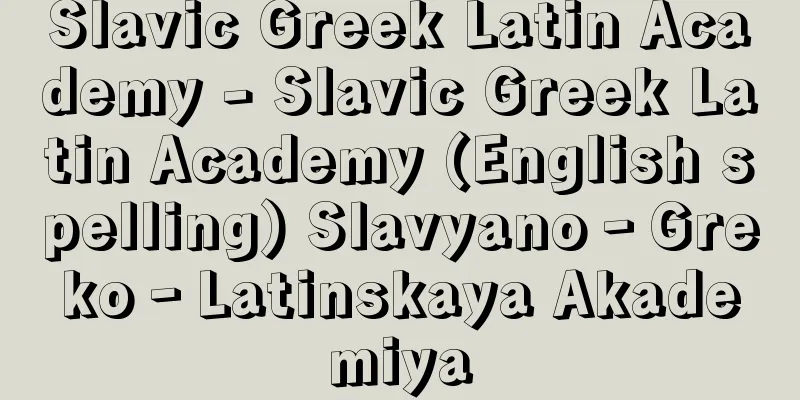Gabrovo - Gabrovo (English spelling)

|
The capital of Gabrovo County in central Bulgaria. It is located on the banks of the Yantra River in the mountainous area at the northern foot of the Stara Planina (Balkan) Mountains. Population 74,949 (2001). In the Middle Ages, it emerged as a Bulgarian town on the mountain road. From the end of the 18th century, industries such as blacksmithing for horseshoes, blades, and firearms, leather, shoemaking, and ceramics flourished by utilizing abundant water power. In the mid-19th century, the braiding industry using gear machines developed, giving rise to handicraft factories, and trading posts were opened in Bucharest, Moscow, Odessa, and other places to trade these products. This class of merchants gained economic power and came into contact with Western European culture, and they developed a sense of national identity, and in 1835 the first school independent of the church was established with the aim of providing education in secular Bulgarian. When Bulgaria gained independence in 1978, many small and medium-sized companies were established as joint stock companies, and by 1947, 220 factories were in operation. Since then, textiles, leather, and shoemaking have been important industries, and there is also an industrial university. There is an art museum with a humorous and satirical theme in the city, and in the suburb of Etǎr there is an ethnographic museum that recreates the streetscape of the Bulgarian Revival period and demonstrates and preserves traditional craftsmanship. [Kenji Terashima] Source: Shogakukan Encyclopedia Nipponica About Encyclopedia Nipponica Information | Legend |
|
ブルガリア中部、ガブロボ県の県都。スタラ・プラニナ(バルカン)山脈北麓(ほくろく)の山間部、ヤントラ川岸に位置する。人口7万4949(2001)。中世に山脈越えの街道のブルガリア人の町として勃興(ぼっこう)した。18世紀末から豊富な水力を利用して蹄鉄(ていてつ)、刃物、銃器などの鍛冶(かじ)業や皮革、製靴業、窯業などの産業が栄えた。19世紀中ごろには歯車式機械による組紐(くみひも)業が発展して手工業的な工場が生まれ、ブカレスト、モスクワ、オデッサなどにこれを取引する商館が開設された。経済力をつけ西ヨーロッパの文化に接触したこのような商人層から民族的自覚が生まれ、1835年に世俗のブルガリア語による教育を目的とする、教会から独立した最初の学校が設立された。78年にブルガリアが独立すると株式会社組織の中小企業が多く設立され、1947年には220の工場が操業していた。以後は繊維、皮革、製靴が重要な産業で、工業大学もある。市内にユーモアと風刺をテーマとした美術館があり、郊外のエティルEtǎrには民族復興期の町並みを再現し、職人の伝統技術を実演、保存する民俗博物館がある。 [寺島憲治] 出典 小学館 日本大百科全書(ニッポニカ)日本大百科全書(ニッポニカ)について 情報 | 凡例 |
<<: Capromis (English) Cuban hutia
Recommend
Cassendi - Cassendi
...The ancient Egyptians believed that blood repr...
Skamandros
…Because water is essential for the creation and ...
Zhili Province - Zhili Province
An administrative division of China during the Qin...
Visible Light - Intelligent
Same as "visible light." Source: About S...
The Left National History - Sakokushikan
This refers to four Chinese historical texts: Zuo...
Energy Metabolic Rate - Energy Metabolic Rate
A value that calculates how many times the basal m...
Elm
〘Noun〙 (elm) English name of the genus Ulmus of th...
Vajra - Kongosho
An ancient Indian weapon. In Sanskrit it is calle...
Hyemoschus aquaticus (English spelling) Hyemoschus aquaticus
...The stomach is divided into four chambers for ...
Phytoecdysone
...20-OH-ecdysone has been isolated and identifie...
Osaga (angry rockfish)
A marine fish belonging to the order Scorpaenifor...
Torroja, E. (English spelling) TorrojaE
...The expression of irrationality through ration...
Espronceda, José de
Born: March 25, 1803, Almendralejo, Badajoz [died]...
Conquest of Shikoku
This was the battle in 1585 (Tensho 13) when Toyo...
Fulani Kingdom - Fulani Kingdom
An Islamic theocracy that expanded into northern N...


![Kanayama [town] - Kanayama](/upload/images/67cb3ab16a1a1.webp)






